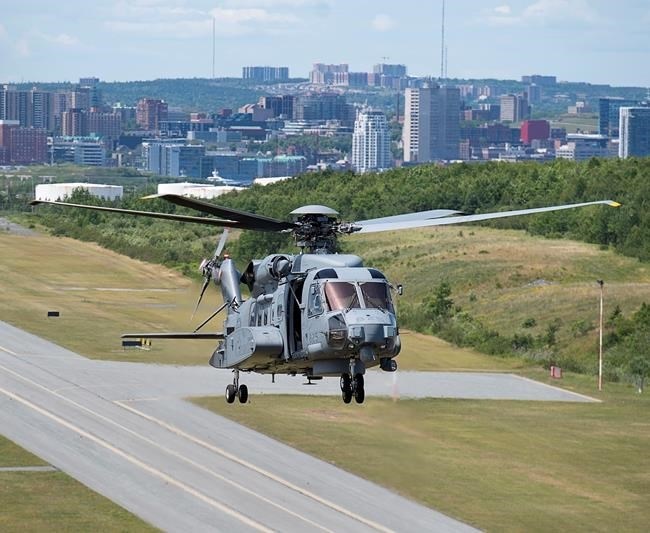
CH-148 Cyclone flies over the runway at 12 Wing Shearwater, in Halifax on Friday, July 13, 2018. The Cyclone will have its first international deployment with the frigate HMCS Ville de Quebec next week when it joins Operation Reassurance, an ongoing multinational NATO mission in the Mediterranean.
Image Credit: THE CANADIAN PRESS/Andrew Vaughan
July 14, 2018 - 10:30 AM
HALIFAX - Two CH-148 Cyclones soared over Halifax harbour on Friday, marking a critical step in the oft-delayed rollout of the Canadian military's fleet of new maritime helicopters.
The state-of-the-art helicopters buzzed past the city's waterfront and hugged the Nova Scotia coastline in an aerial display staged by the Royal Canadian Air Force, days before one of the aircraft is scheduled to head out on its first international deployment — and about 10 years after the first Sikorsky machine was to be delivered to the military.
Col. Sid Connor, commander of 12 Wing Shearwater in Halifax, said the beefy, flat-grey choppers offer a starkly different flying experience than their geriatric predecessor, the CH-124 Sea Kings, due largely to their suite of sophisticated computerized systems.
The main difference, he said, is that Cyclone crews will be using advanced fly-by-wire technology, which means computers and other electronic gear will help with the flying, rather that relying on manual flight controls.
"It's pretty exciting for all of us," he said in a sprawling hangar, as crew milled around seven of the powerful aircraft. "We know that this is a first step in another chapter of the legacy of maritime helicopter operations, and working with the navy wherever Canada chooses to send us."
Connor, an air combat systems officer, said the Cyclones' communications and sensor systems will extend the reach of navy vessels, for which they serve as their "eyes and ears."
"We're able to give the ship's captain a view over the horizon, either above the water or under the water, at much greater ranges than we could have in the past," he said.
Those skills will be put to the test when one of the 13 Cyclones now at Shearwater deploys with the frigate HMCS Ville de Quebec on Wednesday for a six-month mission, with a 19-member air detachment crew from the 423 Maritime Helicopter Squadron.
The vessel is slated to relieve HMCS St. John's in Operation Reassurance, an ongoing multinational NATO mission in the Mediterranean. Another Cyclone is due to join the mission in January to replace the one leaving Wednesday.
The air force showcased two of the CH-148s before the deployment, breezing up the harbour and tilting in tight, low turns in its busy basin. Technicians also showed off the helicopter's hoisting capabilities, lowering a crew member to the ground as the Cyclone held a steady position overhead in buffeting winds.
Connor said it's been a big adjustment for crews, but so far the feedback has been positive.
"It's quite an amazing change for the pilots," he said. "For the younger crowd, they've really taken to this helicopter because they're so used to this technology ... This is a completely different type of flying, for sure."
The deployment of the twin-engine Cyclone marks a significant milestone for the 17-metre, 13,000-kilogram aircraft.
In January, the East Coast fleet of Sea Kings was retired after 54 years of service.
The Cyclone fleet will be tasked with surface and sub-surface surveillance, and search and rescue missions, while providing "tactical transport for national and international security efforts," according to the military. Its aluminum and composite airframe is built with lightning-strike and high-intensity radio frequency pulse protection.
The Cyclone can fly in temperatures ranging from -51 C to 49 C.
"It is an amazing machine," Dan Ross, a former assistant deputy minister of defence materiel, said from Ottawa. "You push one button and the complex rotor head and tail all fold in like a transformer. All the latest technology has been built up into it."
Ross, who for seven years oversaw billions of dollars in military contracts before leaving in 2013, said the process of getting the aircraft online may have taken a long time, but was realistic when it came to testing and development standards.
In 2003, the Liberal government chose the military version of the Sikorsky S-92, and they later signed a $5-billion contract to buy 28 Cyclones, the first of which was supposed to arrive at Shearwater in 2008.
Since then, there have been disputes over the readiness of software needed to run the aircraft, and Sikorsky has blamed repeated delays on changes the military has demanded to the design, including a requirement for stronger engines.
In October 2010, the federal auditor general criticized the Cyclone project, saying cost overruns had hit $700 million.
The first interim CH-148 Cyclone arrived at Shearwater in May 2011, but that model was for ground-based training only.
The remainder of the helicopters are expected to be fully operational by 2021.
The Sea Kings operating on the West Coast at Patricia Bay near Victoria will remain in operation until the end of this year.
News from © The Canadian Press, 2018